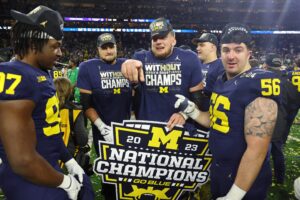Ohio State quarterback Justin Fields has announced his intentions of entering the NFL draft.
Only two years after transferring from Georgia, the junior quarterback is leaving Columbus as one of the all-time greats. After only 22 games, Fields leaves Ohio State as the 11th-ranked quarterback in career passing yards and second in passing touchdowns. He has top-three single-season totals in both of those categories from last year. The Sugar Bowl against Clemson in 2021 was the bet game of his career, in which he tied the school record for single-game passing touchdowns, and is eighth in single-game passing yards.
Ryan Day is changing the identity of Ohio State’s offense, and he’s starting with Fields. No longer is Ohio State a run-first offense with enough passes to keep the defense on their heels. The Buckeyes are becoming a passing team, with potentially two quarterbacks drafted in the first round over the last three years.
Ohio State is trying to become Quarterback University, and Fields is helping get it done.
It’s a shame that Ohio State only got Fields for one full season. His last year was in the shortened COVID-19 pandemic, so he only played 22 games in scarlet and gray.
J.T. Barrett is the Buckeyes’ career leader in every passing category, but he played in 50 games. If Fields had that many games, how many of Barrett’s records could he have broken?
Clearly, the best quarterbacks in Buckeye history are the last three starters: Fields, Dwayne Haskins, and Barrett. Each of them have a case to be the best quarterback in Ohio State history.
With Fields going to the NFL, what is his legacy in Columbus? Where does he rank among the top Buckeye quarterbacks?
Where Does Justin Fields Rank Among Ohio State Quarterbacks?
Single Season Stats
Fields only played in one full season, which was in 2019. He played in 14 games in his sophomore year, as opposed to only eight in 2020. But his first year was one of the most productive in Buckeye history, only behind Haskins’ 2018 season.
In 2019, Fields completed 67.2 percent of his passes for 3,272 yards, 41 touchdowns, and only three interceptions. His passing yardage was only 57 yards short of reaching second place in Buckeye history. His passing touchdowns were enough to get him right behind Haskins.
In 2018, Haskins put up 4,831 passing yards, 50 touchdowns, eight interceptions, and completed 70 percent of his passes. At first glance, it looks like Haskins’ season was far more impressive than Fields.
A Different Game For Haskins
Looking closer, Haskins was asked to pass far more than Fields. Haskins averaged 38 attempts a game in 2018. In 2019, Fields only attempted 25 passes a game, so naturally. Haskins’ numbers are inflated due to lack of run game. In 2019, J.K. Dobbins became Ohio State’s first 2,000-yard rusher. Haskins never had the run support that Fields did. Under Haskins, Ohio State rushed for 177 yards per game. With Fields, they Buckeyes ran for 267 yards per game. Fields himself rushed for 484 yards in 2019, while Haskins gained 108 on the ground the year before.
Another reason for Haskins’ offensive explosion is that in 2018, Ohio State’s defense played below it’s normal standards. Shootouts against Purdue and Maryland resulted in Haskins having to play hero. In fact, the loss to Purdue and the overtime win over Maryland are both top-six in Ohio State history for single-game passing yards. Haskins has five of the six 400-yard passing games in Buckeye history because Ohio State needed him to in order to win.
While Fields didn’t have the pure numbers, he was a more efficient passer than Haskins. In 2018, Haskins passed for 9.1 yards per attempt and 0.09 touchdowns per attempt. The next year, Fields passed for 9.2 yards per attempt and 0.12 touchdowns per attempt. Fields’ quarterback rating was better than Haskins as well, at 181.4 as opposed to 174.1.
While it appears that Haskins put together a much better season than Fields ever did, it’s actually closer than it seems.
Career Stats
Barrett left Ohio State as not only the most decorated quarterback in Buckeye history, but Big Ten history.
In his four years from 2014-2017, Barrett won the Griese-Brees Quarterback of the Year award three times. He was named First-Team All-Big Ten three times as well. Barrett won the Thompson-Randle El Freshman of the Year award in 2014 and was the MVP of the Buckeye’s bowl games in 2016 and 2017.
Barrett broke Drew Brees’ record for career passing touchdowns, which nearly stood for 20 years. When he left, he was fourth all-time in completion percentage, third in passer rating, and eighth in passing yards.
He is also five yards ahead of Brees for total yards in Big Ten history. Barrett also leads the Big Ten in total touchdowns responsible for, and is 41 ahead of Brees in that category.
Barrett is still the Ohio State leader in career passing yards and passing touchdowns. He is also tied for fourth in rushing touchdowns and eighth in rushing yards.
However, Barrett had 50 games in which to accomplish these feats. Fields had less than half of that.
In two fewer seasons, Fields won the Griese-Brees Quarterback of the Year award twice and was named First-Team All-Big Ten twice. Fields also won the Graham-George Offensive Player of the Year award twice and was a Heisman finalist once, which are two honors Barrett never attained.
Given the number of games they played, the two are almost equal in the hardware department. In fact, Fields might have done better for himself than Barrett.
Fields’ Passing Game
Once again, Fields’ efficiency gives him the advantage over Barrett. Despite playing in half of the games, Fields has the highest yards per attempt ratio in Big Ten history. Fields doesn’t rank in career completion percentage in the Big Ten because he doesn’t have enough attempts. But if his 579 were enough to qualify, his career percentage of 68.4 would easily top the Big Ten.
It is important to keep in mind that the two quarterbacks were from different eras. Even though they only played two years apart, Ohio State’s offense changed heavily in that time.
Under Barrett and Urban Meyer, the quarterback was just as much a runner as a passer. That may sound like exaggeration, but Barrett has 769 passing attempts and 656 rushing attempts in 50 games. In 36 games since Barrett left, Haskins and Fields combined for 929 passes and only 297 rushes.
Barrett’s main job was to run the read option and use the passing game as an extension of the running game. Ohio State did throw deep with Barrett, but it was when they drew the defense in with the run game.
Now, Ohio State still uses the read option, but it is only one arrow in a quiver of many. Ohio State is moving away from dual-threat quarterbacks like Terrelle Pryor, Braxton Miller, and Barrett in favor of pro-style passers.
In fact, between the recruiting classes of 2020 and 2022, Ohio State has signed three pro-style quarterbacks (C.J. Stroud, Jack Miller, and Kyle McCord) and has one pro-style quarterback commit (Quinn Ewers).
Haskins was the first Ohio State quarterback to run such an offense, but Fields continued it. As good as Barrett was, he wouldn’t have been able to handle the passing responsibilities of the modern Buckeye quarterback.
Justin Fields’ Quarterback Legacy At Ohio State
What will Fields’ legacy be?
For starters, Fields is the only quarterback of the three to win a College Football Playoff game.
Barrett got his team to the playoff in 2014, but didn’t play because of an injury. Even though Barrett was on the National Championship team, his only playoff appearance was a shutout loss to Clemson.
Haskins did not appear in the playoff in his lone season as a starter.
This means that in two years, Fields has more starts in a playoff game as Barrett and Haskins combined. Fields is also the only one to play in a National Championship game.
After Ohio State won it all in 2014, they failed to look like a contender for the next several years. Ohio State only made it to one CFP over the next four seasons, and were shut out in their only appearance.
Ohio State should have been a top team in the country, but they weren’t.
When Ryan Day took over in 2019, he changed that. Fields came in that year and made it to two straight playoff berths and one National Championship.
Barrett and Haskins had high expectations and failed to live up to them. Fields came in with a new head coach in a time of change, and blew everyone away.
Aside from the numbers, the trophies, and the awards, Fields will be remembered as the quarterback who helped get Ohio State back on track.






